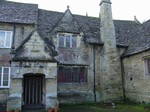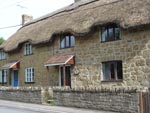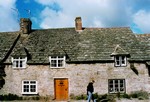|
|
ENGLISH STONE FORUM |
|
.
|
Home
> Issues > Building stone industry in Britain
1
| 2 | 3&4
| 5 | 6
| 7 | 8
| 9 | 10
| 11
|
|
|
10.
Lower Jurassic building stone resources
Although no longer a primary source of building stone, the Lower Jurassic or Lias limestones were widely used for local buildings in the past. The blocky grey limestones, particularly well developed in the basal part of the succession (Blue Lias), are commonly seen in the walls of older houses along the whole of the outcrop from the Dorset coast to Yorkshire. Good examples can still be seen in buildings at, for example Lyme Regis, Street, Bristol, Cardiff and Newar., Today only a few quarries in Somerset are still able to supply this stone for building purposes. Higher in the Lower Jurassic succession occur the Middle Lias ironstones (Fig.??). Best developed in Oxfordshire (Hornton Stone), Northampton and Lincolnshire (Marlstone Rock Formation). All were commonly used in the past for local buildings and occasionally exported further afield. To a lesser extent the Lower Lias Frodingham Ironstone was also used for building north of Scunthorpe. Only the Oxfordshire quarries are still operating and new sources of the stone are urgently needed if conservation of the large, and rapidly decaying building stock, in the other areas is to be supported. Within the Upper Lias only the orange-brown, Ham Hill Stone from Somerset, a locally developed ferruginous, sandy and shelly limestone, has been widely used as a building stone and is still actively quarried (Durman 2006). These typical grey Lias limestones pass laterally into coarser conglomeratic limestones, representing beach or cliff-line depositsion at the coastline of this Lower Jurassic sea. They are preserved only in the South Wales and Bristol areas. In South Wales these whitish, coarse grained Lias rocks are termed the Sutton Stone and in the Bristol / Somerset area the Brockley Down Limestone (Downside Stone), both have been widely used locally as building stones. |

Middle Jurassic limestone Cricklade |
Middle
Jurassic building stone resources
The principal source of building limestones in the UK is the Middle Jurassic succession of southern and eastern England, many of the limestones having been quarried for building stones since Roman times. The Middle Jurassic of this area comprises the Inferior and Great Oolite Limestone groups, a mixed succession of calcareous mudstones and coarsely oolitic and shelly limestones. Even though they may be quarried at widely different localities the Middle Jurassic limestones often show very similar characteristics and it can be difficult for the untrained eye to tell them apart. Most of the limestone beds have been worked for freestone for building, at least on a local scale but some have reached a pre-eminent position in our building stone history. The limestones of the Inferior Oolite Group outcrop extensively from Dorset to Lincoln. Some of the best known freestones from this unit include the Guiting, Doulting (Wells Cathedral), Dundry (Llandaff Cathedral), Whittington (Cheltenham Stone; Price 2007) and Painswick stones of Gloucestershire and Somerset and the Lincolnshire Limestones from Ketton (various Cambridge colleges), Clipsham (extensively used for on-going restoration the Palace of Westminster), Weldon, Barnack (Peterborough Cathedral), Stamford, Ancaster (Wollaton Hall) and Lincoln (Silver Bed of Lincoln Cathedral) in Rutland & Lincolnshire. The high quality of these stones is self evident from their widespread and continuing usage and it bears repeating that the geological term Inferior Oolite has nothing at all to do with quality and is used simply to denote their position beneath the Great Oolite Group. |

Marlstone at Broadway Gloscestershire
|
In
the Northampton-Kettering area the Inferior Oolite Group also includes
substantial ironstone beds similar in character to those of the Marlstone
Rock Formation in the underlying Lias. These dark orange-brown, shelly
and oolitic ironstones were also used extensively in the past for building
stone. Good examples of their use can be seen at Blisworth and Wellingborough
(Sutherland 2003).
The limestones of the overlying Great Oolite Group include the important Bath stones (Box Ground, Stoke Ground, Westwood Ground, Combe Down, Monk's Park etc.), the Cotswold and Oxfordshire stones (Taynton, Windrush, Barrington etc. Arkell 1977) and others that are locally important such as the Blisworth Limestone. The Bath Stone mines and quarries have a long history of production going back to Roman times. Their greatest phase of exploitation took place throughout the 19th century when these pale yellow oolitic limestones were widely exported for use in the towns and cities of the southern Britain. London, for example, has many 19th century buildings originally built of Bath Stone (Buckingham Palace, Aspley House). Mining of the stone was so extensive that much of the environs of Bath are undermined by tens of kilometres of subterranean caverns. Over much of the Cotswolds the Great Oolite limestones, though of equally high quality and extensively quarried for local building, never achieved the enviable reputations and hence commercial success of either the neighbouring Bath or Oxford stone quarries. The best known of the Oxford stones is probably the Taynton Stone, which together with stones from several other quarries along the Windrush valley, were used extensively in many of the prestigious Oxford colleges, churches and other buildings in the area (Bleinheim Palace), from Medieval times until relatively recently. |

Cotswold stone slates used as wall cladding |
Within
the Middle Jurassic succession other limestone units were exploited not
as freestone but because of their well developed thinly bedded and fissile
nature (Hughes 2003). Such fissile limestone units could be split into
thin sheets and dressed to provide stone slates for roofing local buildings.
Extensive quarrying and mining of these limestones also took place across the outcrop from the Cotswolds into Rutland. Stonesfield (Oxfordshire) and Colleyweston (Rutland) were two of the better known areas of stone slate mining but dozens of small quarries also exploited the limestones from other limestone units like the Forest Marble (Judd 1875; Woodward 1894; Aston 1974) Upper Jurassic building limestone
resources
|

Purbeck stone for walls and roofs |
Other limestones from the Upper Jurassic which have been exploited for building on a local scale are the oolitic limestones of the Corallian Group in the Headington and Wheatley quarries of Oxfordshire. They were originally the first choice stone for many college buildings in Oxford but poor durability eventually restricted their use far outside the local area. Corallian limestones were also used in the North Yorkshire Abbeys at Rievaulx and Byland (Senior 19??) Limestones from the Isle of Purbeck area of Dorset were also commonly worked in mines along their coastal outcrop. Perhaps more famous, however, is the darker so called Purbeck 'Marble' a thin, hard fossiliferous freshwater limestone which when cut and polished was widely used to make decorative columns and fonts in churches and cathedrals throughout southern England (Woodward 1894). Heavy stone slates were also produced from the thinner beds of Purbeck limestone, notably at Swanage and Swindon (Arkell 1947). |
| 1 | 2 | 3&4 | 5 | 6 | 7 | 8 | 9 | 10 | 11 | |
| . |
|